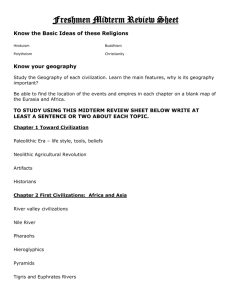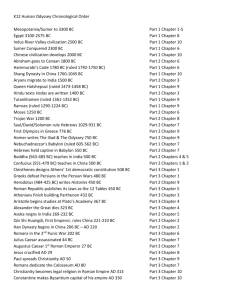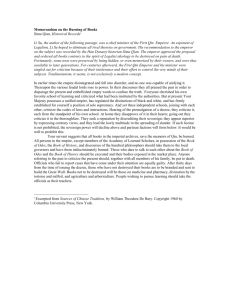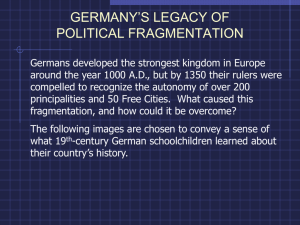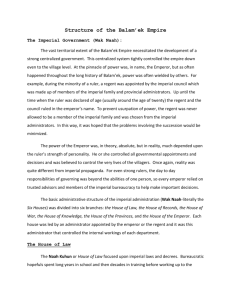Han China, Mauryan and Gupta, Roman Empire
advertisement
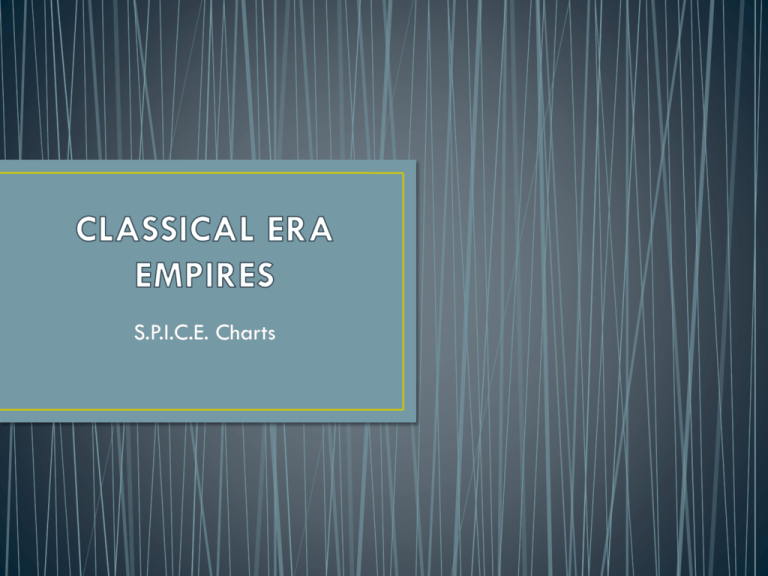
S.P.I.C.E. Charts • SOCIAL: • Relatively small amounts of slavery (1%...) • Bureaucrats at top of social pyramid…followed by landlord class, peasants, then merchants • Confucianism’s five relationships organized power • Extremely patriarchal society…women deferred to all • Some social mobility through education/bureaucratic training • Philosophy of filial piety guided family views • Legalism valued farmers/warriors most • Peasant rebellions brought down Han dynasty • Empire controlled from Korea to Vietnam • Emperors/dynasties ruled through “Mandate of Heaven” • Emperor = Son of God • Emperor Subjects top of Confucian power dynamic • Imperial decline due to: • Invasions of nomadic Huns and Xiongu peoples • Rivalries and government infighting • Peasant rebellions • Highly centralized government • Uniform tax policy • Single law code • Enormous government bureaucracy • Bureaucrats trained in Imperial Academy’s (up to 30,000 at one time) • Civil Service examinations • Mostly sons of landed upper-class • Confucianism guided view of rulers (benevolent, moral) • First Emperor after Period of Warring States = Qin Shihuangdi • Chinese empire born during this time period, lasted til almost present day • China more isolated than other empires at this time • Direct contact with India, indirect trade with Roman empire • Relied on Yellow River for irrigation of crops • Confucianism • Defined Han government rule • Morals, ethics, modesty, deference, etc. • Strong emphasis on education and self-improvement • Daoism • Seen as complement of Confucian values • Natural, self-reliance, community driven • Legalism • Strong laws needed to control man’s evil • • • • • • Beginnings of secular Chinese society at this time Encouraged adoption of language, culture, etc. of all conquered peoples Chinese language unified under Qin (Mandarin Chinese) Flourishing literature and art during Classical era Buddhism spread into China after Han collapse Invented the stirrup • Revolutionized long distance travel • • • • • Qin standardized coinage, weights & measures Silk manufacturing very important Economy based on agriculture Trade with India and Roman empires Merchants not socially/politically powerful, even if economically rich • SOCIAL • Caste system main organizer of Hindu society • Brahmins (Priests) Nobles/Warriors Merchants Peasants “Untouchables” • Differing theories on origin: Racial “Varna” vs. Job Specialization “Jati” • No social mobility • Extremely patriarchal society – women must always be under supervision of man • Buddhism less patriarchal, but NOT equal • Slaves were present, and received some protection through religious beliefs • Mauryan kingdom divided amongst governors • Emerged from remnants of Alexander the Greats, Hellenistic empire • Chandragupta Maurya united area ruled in 324b.c.e. • Relied on large army to control • System of government spies to maintain rule • Emperor Ashoka was famous military ruler and later convert to Buddhism in response to the death he created • Diversity of population and caste system loyalties made centralized government difficult • Relatively short-lived empires • Collapse partly due to invasion of nomadic Huns from Central Asia • Huge dependence on yearly monsoon rains to support agriculture • Reliance on fertile Indus and Ganges river valleys • Empire situated at an important crossroads in trade from China to the Mediterranean • Interaction with aggressive nomadic peoples led to decline • The “Vedas” are a collection of sacred Hindu writings that bonded together immense religious diversity • Hindu beliefs of “Samsara,” (reincarnation) and “Karma,” (sum of good/bad deeds) worked to reinforce caste system creation • Written sanskrit language bonded diversity together • Buddhism developed through teachings of Siddhartha Gautama, and provided an alternative to Hinduism • No caste system, no devotion to Gods, shared beliefs in reincarnation and karma • Highly advanced work in astronomy and mathematics • Emperor Ashoka built giant rock “Edicts” that helped spread Buddhism across vast territory • Mauryans established single currency, and standardized weights/measures • Economy centered on agriculture • Location on popular East West trade routes led to accumulation of riches • High taxes helped contribute to collapse of society • Largely exported silk, spices, and luxury goods • SOCIAL • Large divide between “patricians” (rich) & “plebeians” (poor) • Between 30-40% of Roman society made up of slaves • Slave emancipation common • Even middle class citizens owned 2-3 slaves (1000’s for rich) • Not based on ethnicity/race • Mostly war prisoners • Began as a “republic” ruled by “patricians” • • • • Republic headed by two “consuls” (like President & Prime Minister) Written law code protected all citizens’ rights Public assemblies created to give voice to poor Office of “Tribune” created to represent plebeian interests • Empire arose out of: • Punic Wars with Carthage • Rise of powerful class of generals • • • • • • • Caesar Augustus (Octavian) = first emperor Very strong navy and professionally trained army Roman citizenship = right to hold office, legal protection Goal was to control the world Successful expansion due to tolerant treatment of conquered peoples Governors appointed to control territory Decline due to: • Invading Germanic peoples in the north • Lack of tax revenue to support enormous territorial holdings • Political rivalries/corruption • Eastern portion of Roman empire turned into Byzantine after collapse of west in 476 CE • Decline of Romans was never replaced in Western Europe with another imperial system • At its height it controlled territory into Northern Europe (inc. Britain), North Africa, the Mediterranean, and former Persian empire • Germanic peoples on frontiers frequently caused friction, eventually collapse • Exported Greek culture (rationalism, architecture, philosophy, etc) to areas it controlled • Turned dead emperors into Gods • Originally polytheistic • Emperor Constantine’s conversion to Christianity in 4th century C.E. made Christianity a dominant religion • Emperor Theodosius’s declaration of official imperial religion sealed this • Used Christianity as a way to bond empire together • Huge emphasis on elaborate architecture and grand public works • Latin language became basis for later European languages (Spanish, Italian, French, Portuguese…) • “Pax Romana” (Roman Peace) translated into perfect conditions for trade and business • Upper class avoidance of taxes led to decline in imperial revenue and forcing of poor to carry burden • Large discrepancy between few very rich, and majority very poor


